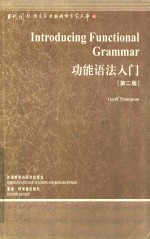图书介绍
功能法语入门=introducing functional grammarPDF|Epub|txt|kindle电子书版本网盘下载

- 著
- 出版社:
- ISBN:
- 出版时间:未知
- 标注页数:0页
- 文件大小:58MB
- 文件页数:339页
- 主题词:
PDF下载
下载说明
功能法语入门=introducing functional grammarPDF格式电子书版下载
下载的文件为RAR压缩包。需要使用解压软件进行解压得到PDF格式图书。建议使用BT下载工具Free Download Manager进行下载,简称FDM(免费,没有广告,支持多平台)。本站资源全部打包为BT种子。所以需要使用专业的BT下载软件进行下载。如BitComet qBittorrent uTorrent等BT下载工具。迅雷目前由于本站不是热门资源。不推荐使用!后期资源热门了。安装了迅雷也可以迅雷进行下载!
(文件页数 要大于 标注页数,上中下等多册电子书除外)
注意:本站所有压缩包均有解压码: 点击下载压缩包解压工具
图书目录
1 The purposes of linguistic analysis1
1.1 Starting points1
1.1.1 Going in through form2
1.1.2 Going in through meaning6
1.2 Language,context and function:a preliminary exploration10
Exercise12
2 Recognizing clauses and clause constituents14
2.1 Breaking up the sentence-and labelling the parts14
2.1.1 Recognizing constituents15
2.1.2 Structural and functional labels18
2.2 Ranks21
Exercises26
3 An overview of functional grammar28
3.1 Three kinds ofmeaning28
3.1.1 The three metafunctions30
3.1.2 Three kinds of function in the clause32
3.1.3 Three kinds of structure in the clause34
3.1.4 Showing the options:systems networks35
3.1.5 A fourth metafunction38
3.2 Register and genre39
3.2.1 Register(and the corpus)40
3.2.2 Genre42
Exercise44
4 Interacting:the interpersonal metafunction45
4.1 Introduction45
4.2 Roles of addressers and audience46
4.3 Mood49
4.3.1 The structure of the Mood49
4.3.2 Identifying Subject and Finite50
4.3.3 Meanings of Subject and Finite52
4.3.4 Mood in non-declarative clauses54
4.3.5 Mood in text58
4.3.6 The Residue60
4.3.7 Modal Adjuncts63
4.4 Modality65
4.4.1 Modality and polarity65
4.4.2 Types of modality67
4.4.3 Modal commitment69
4.4.4 Modal responsibility69
4.4.5 Modality in text72
4.5 Appraisal75
4.6 Interaction and negotiation79
4.7 Interaction through text80
Exercises83
5 Representing the world:the experiential metafunction86
5.1 Introduction86
5.2 Transitivity:processes and participants88
5.2.1 Material processes90
5.2.2 Mental processes92
5.2.3 Relational processes96
5.2.4 Verbal processes100
5.2.5 Other types of process103
5.2.6 Other participant roles105
5.2.7 Circumstances109
5.2.8 Transitivity in text112
5.3 More complex aspects of transitivity116
5.3.1 More on material processes116
5.3.2 More on mental processes117
5.3.3 More on relational processes118
5.3.4 Processes in verbal group complexes124
5.3.5 Participants in causation125
5.4 Transitivity patterns in text126
5.5 Ergativity135
Exercises138
6 Organizing the message:the textual metafunction-Theme141
6.1 Introduction141
6.2 Theme142
6.3 Identifying Theme144
6.3.1 Theme in declarative clauses144
6.3.2 Theme in non-declarative clauses146
6.4 Special thematic structures149
6.4.1 Thematic equatives149
6.4.2 Predicated Theme151
6.4.3 Thematized comment152
6.4.4 Preposed Theme153
6.4.5 Passive clauses and Theme153
6.5 Theme in clause complexes154
6.6 Multiple Theme156
6.6.1 Conjunctions in Theme157
6.6.2 Conjunctive and modal Adjuncts in Theme157
6.6.3 Textual.interpersonal and experiential elements in Theme158
6.6.4 Interrogatives as multiple Themes160
6.7 Some problems in Theme analysis160
6.7.1 Existential'there'in Theme161
6.7.2 Theme in reported clauses161
6.7.3 Interpolations in Theme162
6.7.4 Preposed attributives163
6.8 Theme in text164
6.9 A final note on identifying Theme173
Exercises174
7 Organizing the message:the textual metafunction-cohesion179
7.1 Cohesion and coherence179
7.2 Reference and ellipsis180
7.2.1 Reference180
7.2.2 Ellipsis184
7.3 Conjunction188
7.4 Cohesion in text190
Exercise194
8 Clauses in combination195
8.1 Introduction195
8.2 Units of analysis196
8.3 Types of relations between clauses197
8.3.1 Logical dependency relations198
8.3.2 Logico-semantic relations203
8.4 Expansion204
8.4.1 Elaborating204
8.4.2 Extending206
8.4.3 Enhancing207
8.5 Projection209
8.5.1 Quotes and reports210
8.5.2 Facts213
8.5.3 Projection in text215
Exercises216
9 Grammatical metaphor219
9.1 Introduction219
9.2 Grammatical metaphor220
9.3 Experiential and logical metaphors224
9.4 Interpersonal metaphors231
9.5 Textual metaphor235
9.6 A cautionary note236
Exercises237
10 Implications and applications of functional grammar240
10.1 Three-dimensional analysis of texts240
10.2 A summary review of functional grammar247
10.3 Using functional grammar249
10.4 Closing251
Answers to exercises253
Further reading283
References288
Index293